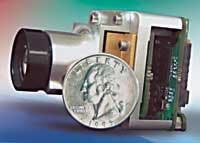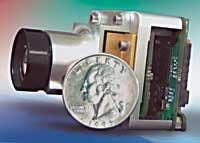Phasebridge wins contract for Navy RF fiber-optic links program
Phasebridge Inc. in Pasadena, Calif., won a U.S. Navy contract to develop integrated fiber-optic transmitters and receivers for the AN/ALR-95 system on the P-3C maritime patrol aircraft. The contract comes from EDO Corp., which is providing the AN/ALR-95 system to U.S. Naval Air Systems Command. Phasebridge will develop fiber-optic transmitter and receiver modules with the company’s hybrid integration technology. The modules will deliver high-bandwidth electronic support measures in the presence of difficult environmental conditions. For more information contact Phasebridge online at www.phasebridge.com.
FLIR Systems adds IR camera to research product line
FLIR Systems Inc. in Wilsonville, Ore., is adding the ThermaCAM SC6000 scientific-grade infrared camera to the company’s line of research and development products. The ThermaCAM SC6000 offers simultaneous and independent analog and digital output data streams to send corrected imagery to a video monitor while uncorrected data flows to a digital recording system, for example. The camera operates at 120 frames per second at 640-by-512-pixel resolution or 420 frames per second at 320-by-256-pixel resolution. Optional software provides tools to automate data acquisition, analysis, and reporting, or to enable custom programming for integration with other software applications. For more information contact FLIR Systems online at www.flirthermography.com.
Optex to provide telescopes for howitzer fire control
Optex Systems Inc. in Richardson, Texas, will provide panoramic telescopes for the U.S. Army’s M119 howitzer fire-control system. Company optical technicians are doing the work under terms of a $28 million contract awarded Aug. 3 from the Army Tank-automotive and Armaments Command Rock Island at Rock Island, Ill. Work will be in Richardson, Texas, and will be finished by June 2010. For more information contact Optex by phone at 972-644-0722.
Kollsman to repair optical system on Cobra helicopter
Kollsman Inc. in Merrimack, N.H., won a $14 million order to repair the telescopic sight unit on the U.S. Marine Corps AH-1W attack helicopter. Work will be in Merrimack, N.H., and will be finished by December 2006. This contract award was based on limited competition since only two sources are approved to repair this item. Awarding the contract order is the U.S. Naval Inventory Control Point. The order number is 5041.
Prototype shortwave IR cameras delivered to Army
Engineers at Sensors Unlimited Inc. in Princeton, N.J., delivered four small high-sensitivity shortwave infrared camera prototypes for the Soldier Mobility and Rifle Targeting System, otherwise known as SMaRTS. The Sensors Unlimited SU320KTX cameras represent a new format that uses the company’s 320-by-240-pixel focal-plane-array commercially available in its SU320MX cameras. Sensors Unlimited designed the cameras with experts at Kaiser Electro-Optics, a Rockwell Collins company in Carlsbad, Calif. The miniature prototype shortwave infrared imager is for use in day or nighttime operations. It weighs 80 grams without a lens, uses less than 1.6 watts, and has high sensitivity for potential use on the SMaRTS helmet system from Kaiser Electro-Optics. The small detector and board also could be packaged as an imaging engine for other systems, Sensors Unlimited officials say. The packaging offers a custom lens with a 40-degree field of view. The camera supports an RS-170 video-compatible output and a 12-bit digital camera-link output. Voltage input ranges from 7 to 16 volts. For more information contact Sensors Unlimited online at www.sensorsinc.com.
Coherent to help enhance Special Forces technology
Coherent Systems International Corp. in Lexington Park, Md., won an $8.1 million contract to blend new and emerging technologies with promising open-architecture commercial off-the-shelf (COTS) components into a field-deployable system for U.S. Special Forces. The result will be a mobile link interoperable with U.S. and allied military forces to improve situational awareness to the warfighter. The system will work together with the Battlefield Air Operations (BAO) Kit program to boost the technological capabilities of Special Forces operating in austere, remote environments with little, if any, infrastructure support. The BAO Kit uses advanced COTS technology supports Special Forces strike operations that require time-critical and time-sensitive targeting. The contract also calls for Coherent Systems to demonstrate ways to streamline acquisition and fielding. Coherent Systems is to finish the work in December 2006. Awarding the contract is the U.S. Air Force Research Laboratory at Wright-Patterson Air Force Base, Ohio. Coherent is a small business specializing in electronic warfare, radar, target identification and weapons system development. For more information contact Coherent Systems online at www.coherentsys.com.
Global Hawk UAV uses Raytheon integrated radar-optical sensor suite
Raytheon Co. in El Segundo, Calif., delivered the first full-production Integrated Sensor Suite (ISS) for the Northrop Grumman RQ-4A Global Hawk unmanned aerial system, used by the U.S. Air Force. The configuration includes synthetic aperture radar (SAR) and electro-optical/infrared (EO/IR) high-resolution imaging capability. Raytheon’s ISS provides near real-time imagery. The enhanced ISS extends the range capabilities of the SAR and EO sensors by 50 percent over the basic ISS, company officials say. For more information, see www.raytheon.com.
Kollmorgen to develop optoelectronic surveillance systems
Kollmorgen Electro-Optical of Northampton, Mass., won a contract for its SeaScout Electro-Optical Surveillance Systems (EOSS), a stabilized, integrated imaging system that provides 360-degree day and night surveillance, company officials say. The system includes high-resolution color day imaging, multi-field-of-view night vision, automatic perimeter scanning, image tracking, and an eye-safe laser rangefinder. The Sea Scout is a lighter and more compact version of Kollmorgen’s legacy MK46 optical system, which is aboard more the 50 U.S. Navy platforms. The work will be at Kollmorgen’s Northampton, Mass., Brattleboro, Vt., and Groton, Conn., facilities.
Boeing orders helmet-mounted displays from VSI
Vision Systems International LLC (VSI) in Haifa, Israel, won a contract from The Boeing Co. for more than 500 Joint Helmet Mounted Cueing Systems (JHMCS). The JHMCS provides the pilot with “first look, first shot” high off-boresight weapons engagement capabilities. The system enables the pilot to accurately cue onboard weapons and sensors against enemy aircraft and ground targets while performing high-G aircraft maneuvers. Critical information and symbology, such as targeting cues and aircraft performance parameters, are graphically displayed directly on the pilot’s visor. In addition to the JHMCS, VSI is in development of the advanced HMD for the F-35 (JSF), in development of the QuadEye Night Vision Cueing system (NVCD) for the U.S. Navy and in production on the DASH (Display and Sight Helmet) Generation IV HMD under multiple contracts to Lockheed Martin. For more information, see www.vsi-hmcs.com.
DRS wins $22 million contract for next-generation thermal weapon sights
DRS Optronics in Palm Bay, Fla., won a $22 million order to produce the next-generation Medium Weapon Thermal Weapon Sights (TWS II) for the U.S. Marine Corps. DRS Optronics, a division of DRS Technologies in Parsippany, N.J., received the order from the U.S. Army’s Communication-Electronics Life Cycle Management Command (CELCMC) at Fort Monmouth, N.J., acting on behalf of Program Executive Office (PEO) Soldier - Sensors and Lasers for the U.S. Marine Corps. The Medium TWS II will use the company’s uncooled infrared technology. Work for this contract will be in Palm Bay and Melbourne, Fla., and at the DRS Infrared Technologies facility in Dallas. Using advanced microbolometer-based infrared technology, the DRS Medium TWS will provide Marine Corps forces and armament crews with greater range of threat detection and wider field of view at a reduced cost. These sights will better equip the war fighter to see the battlefield and more safely engage the enemy. The Light, Medium and Heavy TWS produced by DRS will mount onto a variety of weapons, including M2, M240, M249, and MK19 machine guns, M4, M16, and M82 assault rifles, M24 and M82 Sniper Weapon Systems, M107 antimateriel guns, M136 rocket launchers, and M203 grenade launchers. For more information contact DRS online at www.drs.com.




